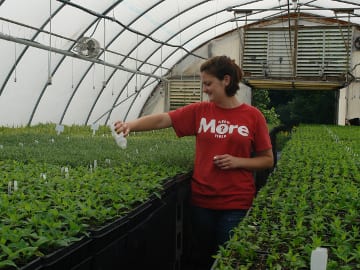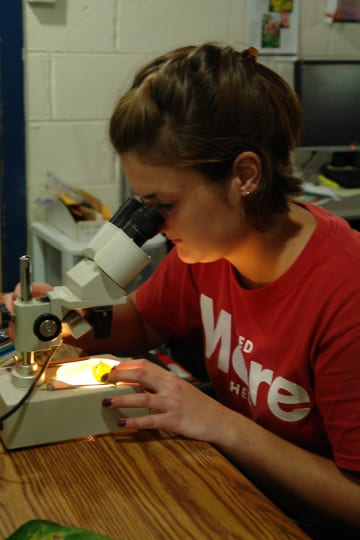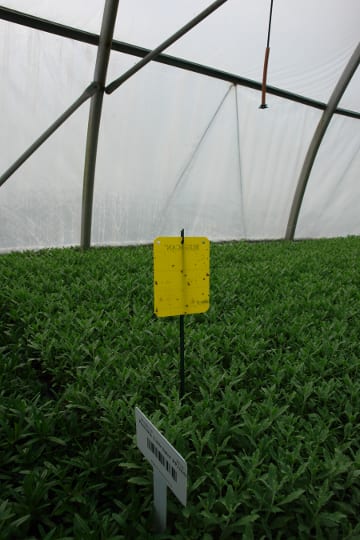A Sustainable Step toward SITES Compliance at North Creek Nurseries
by Nicole Blevins and Tim McGinty
At North Creek Nurseries, we strive to grow our plants safely and sustainably. Protecting people and the environment has been our priority for the past 25 years. The use of pesticides has always been a sensitive subject for us. It is a concern of many of our customers as well, who use our plants to provide food and habitat for wildlife.
We decided years ago to pursue the use of biological control as much as possible in our production operation. In making control decisions, we will always select a biological product first. If one is not available or effective, we will then move to a bio-rational like soap or oil, then an insect growth regulator (IGR), which disrupts the insect’s ability to molt or feed and has an effect specific to the target pest. If these attempts at control fail, we will then select a low-toxicity synthetic that is non-systemic and has the shortest term residual effect possible.
IPM in Practice
Our pest control strategies rely on the practice of Integrated Pest Management (IPM). IPM is a series of pest management evaluations, decisions, and controls that when used in combination with the best available control tactics result in managing pest damage by the most economical means and with the least possible hazard to people and the environment. The goal of an IPM program is not to eradicate all pests. Some pests are tolerable and in fact needed so that their natural enemies remain in the crop. The goal is to reduce the pests to a level where they produce no noticeable damage.
In practicing IPM, we follow the four-tiered approach:
-
-
- Setting Action Thresholds: Prior to taking any pest control action, we first set an action threshold. This is a point at which pest populations or environmental conditions indicate that pest control action must be taken. The level at which pests will become an economic threat is critical to guide future pest control decisions.
- Scouting and Identifying Pests: We monitor for pests and identify them accurately so that appropriate control decisions can be made in conjunction with action thresholds. This monitoring and identification removes the possibility that controls will be used when they are not really needed or that the wrong kind of control will be used.
- Prevention: As a first line of pest control, we work to manage the crop to prevent pests from becoming a threat using cultural methods such as disinfecting the greenhouse and eliminating breeding areas for pests.
- Control: When monitoring and action thresholds indicate that pest control is required, we then determine the proper control method.
-
Taking Advantage of Beneficials
We use beneficial insects as the frontline preventative control in our production houses where temperatures are conducive for year-round use of insect predators or parasitoids. We release them weekly at levels that keep pest populations below our action thresholds for the specific pest. We use beneficials selectively and at different times of the year in other areas of our Nursery, but we have found that the plants coming out of areas treated with beneficials are so free of insects that we can more cost effectively control pest outbreaks using preventative sprays of soaps or oils. We have five significant pests that threaten our crops: fungus gnats, shore flies (a nuisance only), western flower thrips, spider mites, and aphids.
In our production houses, 500 million beneficial nematodes, Steinernema feltiae, are applied weekly via a hydraulic sprayer with a large orifice spray tip, and all the fine screens are removed to avoid damaging or killing them mechanically. The application must take place on cloudy days, or in the morning or evening on sunny days because ultra violet light will kill them. Also, they need time to swim to find their prey, so slow drying of the spray is beneficial. The nematodes aid in the control of fungus gnats and western flower thrips by eating the pupating larvae in the plug media. They have no effect on shore flies which have a similar life cycle to fungus gnats. Shore flies can be controlled with a different nematode species, but we have found it to be cost prohibitive and do not use it. Western flower thrips populations must be controlled at or below our action thresholds or they can vector harmful viruses from crop to crop.
In addition to the nematodes, we use several species of predatory mites to control plant-eating two spotted spider mites and western flower thrips. Specifically, for western flower thrips we use the predatory mite Amblyseius swirskii when temperatures are high in the summer months. For two spotted spider mites, we use a combination of mites as these pests require a particularly aggressive approach to keep them in check. The primary mite used preventatively is Amblyseius californicus. When spider mite populations are on the rise, we will introduce Phytoseiulus persimilis in order to gain further control. Mites are applied by sprinkling or blowing them over the crops.
To control aphids we use a tiny wasp called Aphidius colemani. This wasp will parasitize an aphid by laying its eggs inside of the aphid, and as the eggs hatch the larvae begin feeding on it, eventually killing the aphid. The larvae then pupate and emerge to seek out other prey to parasitize. The dead, parasitized aphids are known as mummies and are easily recognized when scouting. Most of the time releasing this parasitoid bi-weekly is all we need to keep aphid populations in check. When populations get out of control, we try to regain control by releasing green lacewing larvae, also known as aphid lions, into specific hot areas. They actively hunt and devour aphids. They are larger than our other predators and can be easily seen attacking and piercing the prey with their prominent jaw pincers. If aphid populations continue to build, we will use an IGR that paralyzes the jaw muscles of the aphid resulting in inability to feed and starvation in three days. This particular chemistry can harm some of our predatory mites, so we are careful to keep the spray high on the crop where the aphids are found, thus protecting the other predators who are feeding at or near the media.
Meeting Greenhouse Challenges
Controlling disease in greenhouse production is challenging in itself. When using beneficials it becomes more challenging because many of the common fungicides and bactericides will harm our good bugs. When starting the IPM program, we made the decision to apply biological fungicides only when disease pressure was low, from late spring to early fall. We then selected a group of low-toxicity, synthetic fungicides to rotate in with the biologicals when disease pressure increased from late fall to early spring. Our growers were concerned about this approach because greenhouse environments are favorable for disease development and spread over the winter months. We are pleased to note that we are seeing the best control ever, and we no longer have any concerns. Our crops have had less disease issues than they did when applying only synthetic fungicides.
As a nursery that is successfully using biological control, we are looking forward to what the future holds as options for biological control are increasing. The possibilities for improvement and expansion in this developing world of pest management are exciting. The pest management tools we currently utilize have not only given us better control of pests that just a few years ago could not be controlled with many of the synthetic pesticides available, but they have also improved our bottom line by reducing our costs and plant credits. The biggest reward is knowing that our plants are grown in a way that will cause no harm to wildlife in native landscapes.
About the Author
Nicole Blevins is a graduate of the Professional Gardener Program at Longwood Gardens and currently serves as the Stock Plant Manager at North Creek Nurseries in Landenberg, PA. Nicole oversees the stock planting production and maintenance for 18 stock houses and 259 varieties. She has a strong interest in biological pest management and greenhouse production and is also responsible for coordinating North Creek’s beneficial insect program. Nicole can be reached at nicole@northcreeknurseries.com.
Tim McGinty is the Chief Operating Officer & General Manager of North Creek Nurseries, a propagation nursery that specializes in growing starter plants for the wholesale trade and landscape market. After studying at SUNY Oswego, Tim served as Agricultural Field Scout and Research Assistant for Cornell University and was the Propagation Manager for both Congdon & Weller Nursery and The Conard Pyle Company (Star Roses & Plants). Tim is responsible for North Creek’s 5.7 acre growing facility and oversees production scheduling, growing and finishing of North Creek’s 494 line items. He has established North Creek as the first Sustainable Sites Initiative™ (SITES™) compliant nursery in the country, developed a comprehensive farm-wide recycling program, and has also pioneered the North Creek employee-run fruit, herb & vegetable garden. When not at the nursery, you’re likely to find Tim fishing along the Eastern Shore of Maryland, but you can always reach him at tim@northcreeknurseries.com.



